Evolution of the Azores
Air Date: Week of November 13, 2009
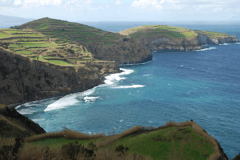
The spectacular northeast coast of San Miguel. The pastures are bordered by the incienso shrub, whose aggressive roots contribute to soil erosion. (Photo: Ken Shulman)
The Azores islands are transforming from a poor, underdeveloped island chain to one of Europe’s most technologically and ecologically innovative regions. Azoreans are using the region’s ample geothermal, hydro and wind resources to make the islands energy independent. But can the nine-island archipelago survive its own success, including an increase in population that threatens to strain its resources? Producer Ken Shulman has our story.
Transcript
YOUNG: It's Living on Earth, I'm Jeff Young. When Portuguese settlers first arrived at the Azore islands in the 15th century, they found what looked to be paradise. Lush vegetation carpeted the volcanic islands. Rock cliffs plunged to the sea, and there were even naturally heated pools of water. But the settlers also found active volcanoes and frequent earthquakes that made nature seem more foe than friend. Ken Shulman visited the Azores and found attitudes about nature on the island beginning to change.
[VOICES SINGING AND CHANTING TOGETHER]
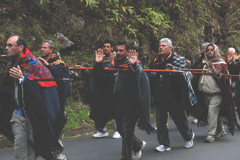
A group of religious pilgrims walks and chants for eight days around the island of San Miguel. (Photo: Ken Shulman)
SHULMAN: A group of ragged pilgrims in woolen shawls chants Ave Maria in Portuguese. Draped in rosaries, carrying wooden staffs, they trudge along the northeast coast of San Miguel, the largest of the Azore islands. The annual pilgrimage dates back to 1532. That’s when settlers first took to the road in a show of penitence after an earthquake leveled their town. Frederico Cardigas is regional director for environmental affairs in the Azores. He says piety and natural disasters still go hand in hand here.
CARDIGAS: They are very connected to catastrophes, because they have volcanoes, they have storms, they have earthquakes, and they are very intense when they happen. And, they destroy peoples’ lands and sometimes they destroy even lives.
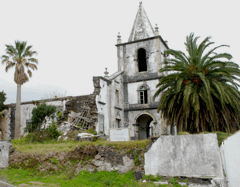
Ruined buildings are a common sight in the Azores. This church on the island of Faial was destroyed in a 1998 earthquake. (Photo: Ken Shulman)
SHULMAN: The Azore islands are set in the Atlantic Ocean, 1,000 miles off the coast of Lisbon. The archipelago straddles the seam of three tectonic plates: North American, Eurasian, and African. Earthquakes are frequent. But these days Azoreans have learned to make geology their friend.
[MACHINE SOUNDS AT GEOTHERMAL PLANT]
SHULMAN: San Miguel’s 130,000 inhabitants get nearly 40 percent of their electricity from geothermal plants like this one in Ribera Grande, San Miguel’s second largest city. Carlos Alberto Bicudo da Ponte is managing director of Sogeo, the company that runs the facility.

The spectacular northeast coast of San Miguel. The pastures are bordered by the incienso shrub, whose aggressive roots contribute to soil erosion. (Photo: Ken Shulman)
DAPONTE: As you see in this landscape there is around steam coming up easily from the earth. This shows the evidence of the content of the energy beneath our feet.
SHULMAN: The Ribera Grande plant runs 24 hours a day and is powered by steam and water. Da Ponte walks me through the orderly tangle of turbines and conduit tubes anchored into a volcanic shelf overlooking the sea.
DAPONTE: It’s very important from a strategic point of view and from the economical point of view to use our indigenous resource, which make our economy more strong and also make us more autonomous in what’s concerned energy. And also, because as you see the environmental impact is very low.
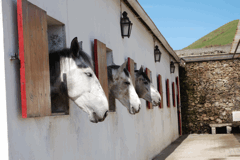
With EU subsidies drying up, many San Miguel dairy farmers are moving into agrotourism. (Photo: Ken Shulman)
SHULMAN: Renewables account for nearly 30 percent of all electricity in the Azores. The rest comes from imported fuel oil, which is pricey and pollutes. Regional officials hope to up the percentage of renewables to 75 by 2018, with a combination of geothermal, hydro, and wind power. Keeping the Azores green is environmentally sound. And green looks good on a region becoming increasingly dependent on tourism.
[COWS CHEWING GRASS]
SHULMAN: But looks can be deceiving. The site of these cows munching grass on the hilltops of San Miguel looks like a billboard for bucolic bliss. Dairy is the island’s most important industry, a loose network of family-owned farms that produce high quality milk, butter, and cheese, primarily for export. But Frederico Cardigas says these man-made pastures are creating major problems for San Miguel. Especially now that climate change has made rains more intense.
CARDIGAS: The soil now has grass instead of forest. And this is also a problem because the grass is not prepared to grab the soil. It’s a problem because if the rain is not captured by the forests then the water is not available for the distribution in the urban areas.
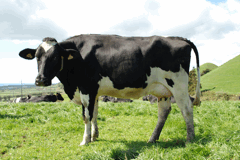
Dairy is the most important industry in the Azores. San Miguel alone counts over 1700 dairy farms. (Photo: Ken Shulman)
SHULMAN: Incenso, the imported shrub that farmers used to mark their land is also contributing to soil erosion. With no native species to keep it in check, incenso has spread all over San Miguel. The roots dislodge trees and even cause landslides. Cardigas says both situations are serious.
CARDIGAS: The best solution of course would be for the natural environment to fight back. And this will happen, because there is this natural trend that native species will adapt for the foreign ones and the foreign ones to native species and they will find a balance. But this will take time, probably hundreds of years and we need answers now.
SHULMAN: Ironically, in this historically impoverished region, the biggest challenge may come from prosperity. Over the past two decades, the Azores have received major European Union investments for infrastructure, industry, and tourism. New highways and the possibility of employment lure many locals to urban areas, changing island lifestyles and landscapes.
[WIND SOUNDS]
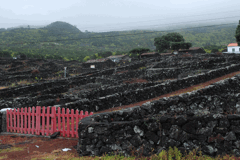
Protected by basalt rock walls, the Pico Vineyards are a UNESCO World Heritage Site. (Photo: Ken Shulman)
SHULMAN: The island of Pico is a bumpy 45-minute flight from San Miguel. The dominant feature is a snowcapped volcano that shares the island’s name. Beneath the massive cone spread these vineyards. A UNESCO world heritage site, the Pico Vineyards are a broad, vaguely lunar maze of dry volcanic rock walls. The walls protect the vines from winds and rain, which are often fierce enough to cancel the 20-minute ferry between Pico and Faial Island. Architect Antonio Vargas takes the ferry every Friday from Faial to tend the family vineyard on Pico. Over dinner, he tells me he’s the last of a kind.
VARGAS: I know the day that I stop working those vineyards they go to waste because there is no one to follow in my footsteps. I don’t see it. Most of the families and men that are in their fifties or are sixty-year-olds right now look back and saying this ends here. This is a lot of agriculture; horticulture; viniculture will stop with this generation when this generation comes to an end.
SHULMAN: Vargas knows the future of the Azores lies in tourism. He’s sad about the end of the traditional island lifestyle. But his livelihood doesn’t depend on it. The same isn’t true for the hundreds of Azoreans leaving family farms to seek work in the city. Pedro Moura is a journalist and hosts of Bom Dia Acores, the morning television news broadcast out of San Miguel.
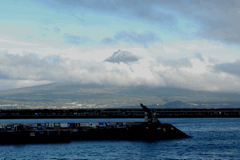
At 7713 feet, the Pico Volcano is the highest point in the Azores and in all of Portugal. The last eruption occurred in 1963 in waters just off the coast. (Photo: Ken Shulman)
[WATER SOUNDS]
MOURA: The rural family in all the islands, they have the possibility to have their own subsistence guaranteed by like a small production in the backyard of the house with one cow, one pig, or one chicken.
SHULMAN: We’re standing on a high cliff overlooking the sea in Rabo de Peixe, an old fishing village on the north coast of San Miguel. Behind us, scores of unemployed boys and men linger near a small church on the town square, smoking, and drinking coffee or brandy a few minutes before noon. Most of them are from rural families recently moved here to cramped, prefab apartments with no space for gardens.
MOURA: They don’t want to work the land; they have no possibilities in the city to have land. So these people, these are the poor and low media class that have problems now.
SHULMAN: There will be more urbanization all across the Azores as EU agricultural subsidies taper off in a few years according to schedule, and as more people in Europe and North America discover its savage, pristine beauty. Tourist visits have increased by nearly 20 percent a year since 2004, and for the first time in more than a century, the Azores are receiving migrants instead of losing their population abroad. For the moment, all these currents are modest. But they’ll need to be managed. Because even if they’re no longer living off the land, Azoreans know their survival will always depend on nature, and on their efforts to preserve it.
[CHURCH BELLS CLANGING]
SHULMAN: For Living On Earth, I’m Ken Shulman, in Rabo de Peixe in the Azores.
Living on Earth wants to hear from you!
Living on Earth
62 Calef Highway, Suite 212
Lee, NH 03861
Telephone: 617-287-4121
E-mail: comments@loe.org
Newsletter [Click here]
Donate to Living on Earth!
Living on Earth is an independent media program and relies entirely on contributions from listeners and institutions supporting public service. Please donate now to preserve an independent environmental voice.
NewsletterLiving on Earth offers a weekly delivery of the show's rundown to your mailbox. Sign up for our newsletter today!
 Sailors For The Sea: Be the change you want to sea.
Sailors For The Sea: Be the change you want to sea.
 The Grantham Foundation for the Protection of the Environment: Committed to protecting and improving the health of the global environment.
The Grantham Foundation for the Protection of the Environment: Committed to protecting and improving the health of the global environment.
 Contribute to Living on Earth and receive, as our gift to you, an archival print of one of Mark Seth Lender's extraordinary wildlife photographs. Follow the link to see Mark's current collection of photographs.
Contribute to Living on Earth and receive, as our gift to you, an archival print of one of Mark Seth Lender's extraordinary wildlife photographs. Follow the link to see Mark's current collection of photographs.
 Buy a signed copy of Mark Seth Lender's book Smeagull the Seagull & support Living on Earth
Buy a signed copy of Mark Seth Lender's book Smeagull the Seagull & support Living on Earth

